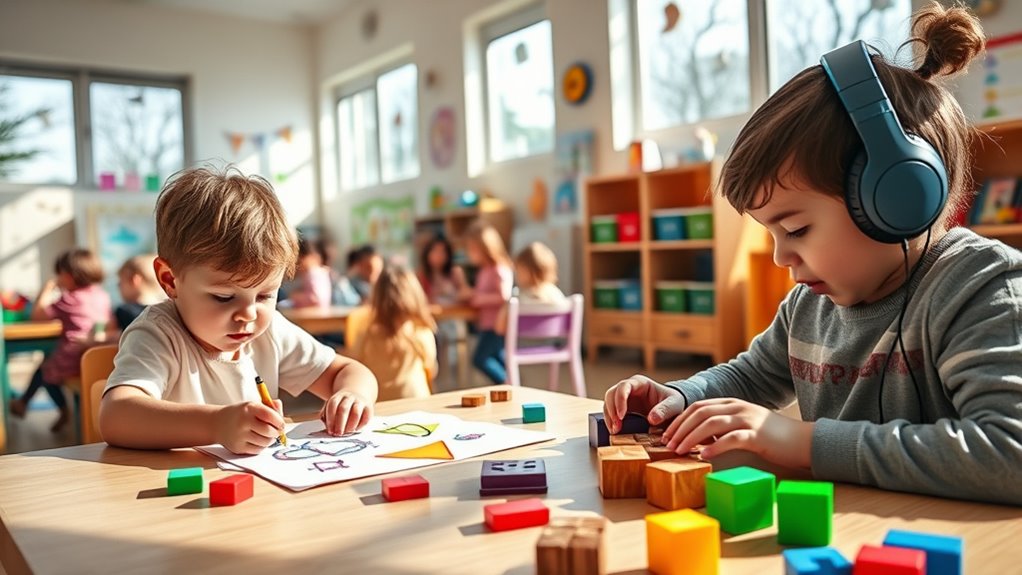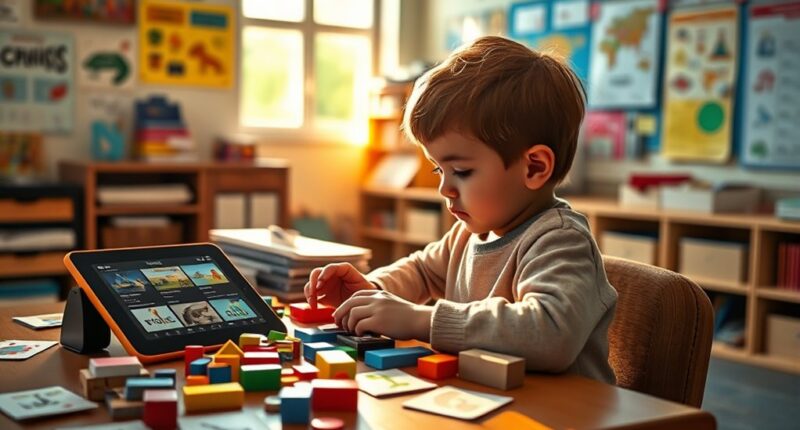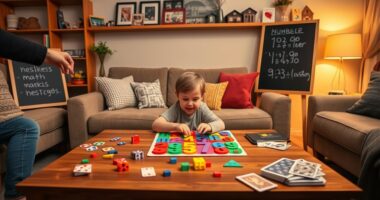Understanding your child’s learning style isn’t about fitting them into a single category. Many children are multimodal, meaning they benefit from combining visual, auditory, and kinesthetic methods. Recognizing their preferences can help you tailor learning activities to boost engagement and retention. Instead of sticking to one label, focus on experimenting with different techniques to see what works best. Stay with us to explore how embracing flexibility can transform your child’s educational journey.
Key Takeaways
- Many children are multimodal learners, benefiting from a mix of visual, auditory, and kinesthetic techniques.
- Strictly labeling a child’s learning style may limit flexibility; focus on what methods enhance their understanding.
- Observing which activities keep your child engaged and improve retention can reveal their most effective learning preferences.
- Incorporating diverse multisensory strategies supports personalized learning and caters to individual differences.
- Flexibility and ongoing assessment are key; learning preferences can evolve over time and should be adapted accordingly.

Understanding your learning style can considerably enhance how you absorb and retain information. When you recognize whether you learn best through visual cues, sounds, touch, or a combination of these, you can tailor your study methods to be more effective. One of the most practical approaches to this is using multisensory techniques. These involve engaging multiple senses simultaneously, making it easier for you to process and remember new information. For example, if you’re a visual learner, you might benefit from diagrams or color-coded notes. If you learn better through touch or movement, incorporating hands-on activities or gestures can boost your understanding. Multisensory techniques aren’t just for students; they’re also valuable tools for teachers and parents. They help foster teaching adaptability, allowing educators to modify their methods to suit different learning preferences. When teaching is adaptable, it’s more inclusive and effective, ensuring that everyone has the opportunity to grasp concepts in a way that resonates with them. This flexibility can be especially beneficial for children who might struggle with traditional teaching methods. By blending visual, auditory, and kinesthetic activities into lessons, you create a dynamic learning environment that caters to diverse needs. For instance, a lesson on history might include watching videos, listening to storytelling, and engaging in role-playing activities. Such an approach not only keeps the child interested but also reinforces learning through multiple pathways. Recognizing the importance of multisensory techniques encourages you to step away from a one-size-fits-all mentality, which often limits learning potential. Instead, you embrace teaching adaptability, making your approach more personalized and responsive. Research also shows that mindfulness practices can support improved focus and emotional regulation, which are beneficial for learning. This can lead to increased motivation and confidence as your child experiences success in understanding difficult concepts. Keep in mind, though, that not everyone fits neatly into a specific learning style box. Many people are multimodal learners, meaning they benefit from a combination of methods. So, don’t get too caught up trying to label your child’s learning style; instead, focus on experimenting with different multisensory strategies. Observe what works best and adapt accordingly. The key is to remain flexible and open-minded, continuously refining your approach to match your child’s evolving needs. Emphasizing multisensory techniques and teaching adaptability can transform the way your child learns, making education a more engaging, effective, and enjoyable experience. Ultimately, understanding and applying these principles helps you support your child’s academic growth and fosters a lifelong love of learning.
Frequently Asked Questions
How Can I Identify My Child’s True Learning Style?
To identify your child’s true learning style, observe how they process information and respond to different activities. Use learning style assessments to gather insights, but remember they’re just tools. Pay attention to whether your child prefers visual aids, hands-on tasks, or listening. Adjust instructional strategies accordingly, emphasizing their natural preferences. This approach helps foster a more engaging learning environment tailored to your child’s unique needs.
Do Learning Styles Change Over Time?
Think of your child’s learning style as a chameleon, changing colors with developmental changes. Yes, learning styles can evolve over time as they grow and face new challenges. Developmental changes influence how they process information, so what works now might not suit them later. Keep observing and adapting, because understanding this learning style evolution helps you support their growth and optimize their learning journey.
Are There Benefits to Teaching Multiple Learning Styles?
You might wonder if teaching multiple learning styles offers benefits. Using multisensory approaches and personalized instruction can enhance engagement and understanding. When you diversify teaching methods, your child benefits from different ways of processing information, which can improve retention and motivation. This approach caters to various preferences, helping your child develop versatile learning skills and boosting confidence, ultimately making learning more effective and enjoyable for them.
What Are Common Misconceptions About Learning Styles?
Many believe that learning styles are fixed traits that determine how your child learns best. However, misconceptions about learning include the myth that teaching to a child’s preferred style improves learning considerably. In reality, research shows that a varied approach benefits all learners, and the idea of strict learning styles can limit educational strategies. Focus on engaging methods rather than labeling your child’s learning preferences, and stay aware of common learning style myths.
How Do Learning Styles Affect Academic Performance?
While the idea of learning styles might seem charming, it’s more about myth than fact. You might think tailoring teaching strategies to a child’s preferred style boosts performance, but research shows that learning style myths don’t substantially impact results. Instead, focus on diverse, evidence-based methods. This approach helps your child develop adaptable skills, ensuring their academic success isn’t limited by misconceptions about their supposed learning style.
Conclusion
So, next time your child struggles with a new subject, don’t rush to label their learning style. Instead, try different approaches—like hands-on activities or visual aids—and see what works best. For example, imagine your child who’s struggling with math starts using colorful charts and manipulatives. Suddenly, concepts click. Remember, focusing on flexible strategies helps your child thrive more than sticking to a supposed “learning style.” Keep experimenting, and watch them grow!









